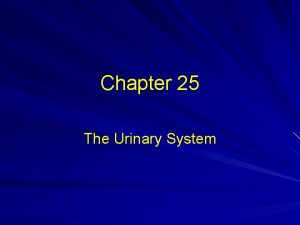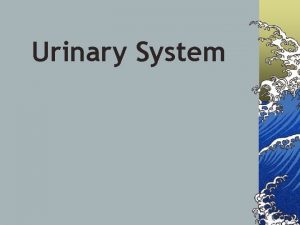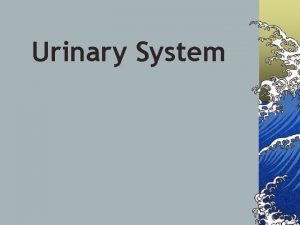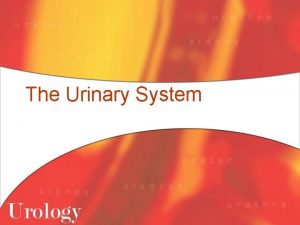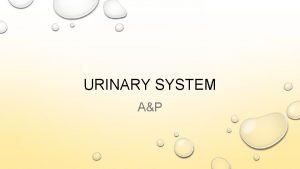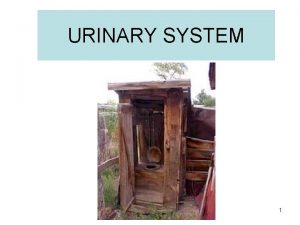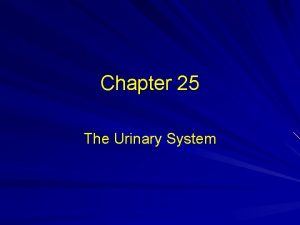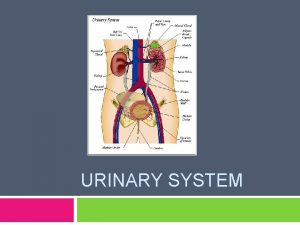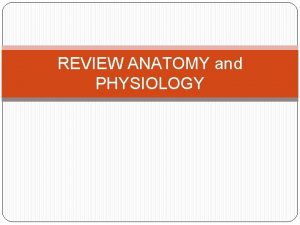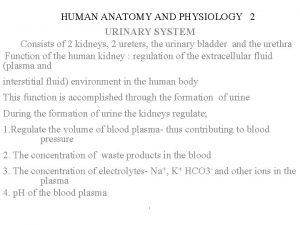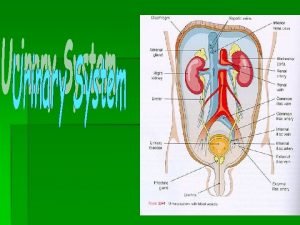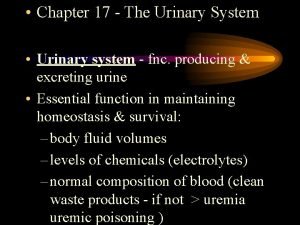The urinary system Urinary system Urinary system consists


















- Slides: 18

The urinary system Urinary system • Urinary system consists of pair of kidneys and urinary tracts which includes (two ureters, urinary bladder and urethra). • Each kidney contains 1. 3 million urinary units called nephrons. • Each nephron consists of glomerulus and urinary ducts (Bowman's capsule, proximal convoluted tubule, Henley loop, distal convoluted tubule and collecting duct).


• Nephrons responsible of urine formation through three sequence process: 1 -Glomerular filtration, the Glomerular filtration rate(GFR) reach 180 liter /day. 2 - Reabsorption 3 - Secretion • Urine components : the kidneys extract the soluble wastes from the blood stream, as well as excess water, sugars, and a variety of other compounds. The resulting urine contains high concentrations of urea and other substances, including toxins. Urine flows from the kidney through the ureter, bladder, and finally the urethra before passing from the body.

Urine composition

Urination • Urination: is a voluntary process depends on person's choice for suitable time and place to empty the urinary bladder from storage urine, without pain. • Disturbances in urination include: 1 - Painful urination, frequency, Urgency. Because of microbial UTI. 2 - Impairment of urine flow, hesitancy, drubbing urine, incomplete emptying. Because of urinary bladder obstruction. 3 - Urinary retention, a sign of benign prostate enlargement (hypertrophy), urinary incontinence (enuresis) due to dysfunction of bladder muscles or sphincter muscles.

Physical examination • 1 -Urine volume: • This is dependent normally up on fluid intake, environmental condition, diet and activity of the human. • Value above or below the normal value (1. 5 L/Day) can be considered as pathological disorder but it should be combined with clinical and laboratory examination. • - above normal (polyuria) urine volume (> 2. 5 -3 L/Day) due to large quantities intake of liquids, diuretics, alcohol, in sufficient of urinary ducts in re-absorption of water and urine concentrated as in diabetes mellitus or diabetes insipidus. • - under normal (Oligourea) urine volume (< 400 ml/Day) • - Anuria, urine volume (< 50 ml/Day), due to: hot weather, sweating, low water intake, or due to disease in kidney or urinary ducts.

• 2 - Color: • Can be observed in a test tube or in a urinometer tube. • Yellow to amber (Normal); the color comes primarily from the presence of urobilin. Urobilin is a final waste product resulting from the breakdown of heme from hemoglobin during the destruction of aging blood cells. • Colorless to pale yellow; dilute urine with low specific gravity and polyuria. • Dark yellow or yellow brown; concentrated urine with a high specific gravity and small quantity. • Yellow brown or greenish yellow; yellow green foam when urine is shaken. Urobilinoids – chromagon derived from heme green biliverdin yellow-brown-billirubin-and urobilin. • Cloudy; hematuria (clearer after centrifugation). • Translucent; hemoglobinuria. • Brown to brownish black; hemoglobin up on standing bile large amounts. • Green; bile biliverdin • Red to pink; phenothiazine (beet root) • Blue; medication contain methylene blue or food with blue dyes.

• 3 -Transparency (clarity): • Clear – freshly voided urine is clear. • Cloudy – not necessarily pathological as many samples may become cloudy. • Epithelial cells – present in large numbers. • Blood – red to brown color and smoky. • Leukocytes – may produce milky, ropy appearance if large number. • Bacteria – produce a uniform turbidity if in large number; the turbidity doesn’t settle out and cannot be removed by filtration.

• 4 -Specific gravity (SG): • Determined by refractometer and indicator paper stripes. Normal value in Man : • 1. 010 – 1. 030 • (Average normal = 1. 025). • depending on SG the urine will be diluted • (SG˂ 1. 002) or concentrated (SG˃1. 065) depend on the solvents in urine. • SG used to determine the kidney efficiency keeping water balance in urine.

5 -Odour: • Normal odor – aromatic or acetone • Abnormal odor – aromatic odor of ketone bodies (sweet fruit odor) as in starvation and diabetes. • In UTI the odor of urine is bad smell. 6 -Foam: Shake the sample and observe: • If the amount of foam produced is in excess and slow to disappear – proteinuria • If the color of the foam great – yellow or brown – bile pigments • If the color of the foam red to brown – hemoglobinuria

Microscopic Examination of Urine Sample • It is of great clinical importance and should never been omitted. Important structure to be include: • Casts: Cylindrical bodies performed in distal collecting tubules from RBCs or WBCs or fatty compounds or waxes. Diagnosis of cast type aid in diagnosis of the disease. • Types of casts: (Hyaline casts, density granulated casts, finely granulated casts, red cell casts (hematouria), and white cell casts (inflammation), wax casts, fat casts, and epithelial casts.

Some of casts shapes appeared under microscope

• Erythrocytes (RBC) and leukocytes (pus cells): present in urine in case of UTI, diseases, and inflammation. • Epithelial cells: presence normally due to sloughing the lining layer of urinary tubules, bladder and urethra or because of some renal diseases. • Budding yeasts: Candida albicans, found in diabetes patients urine because of the low PH and the presence of sugar necessary for the growth. • Protozoa: like Trichomonas vaginalis that infect the vagina in women and urethra in men and cause trichomoniasis. • Mucus: mucus is a slimy secretion that originates from the mucous membranes and glands • Crystals: a salt compounds organized in geometrical shapes and looks like crystals, important in stones formation (cysteine crystals and oxalate crystals). • Amorphous urate – white or pink cloud in acid urine • Amorphous phosphate – white cloud in alkaline urine


Chemical Examination of Urine: • -PH of urine • The normal hydrogen ion (p. H) concentration, in the urine (5 -8) depends on the type of diet. Vegetable diet, citrus fruits (also bacterial infections) produce alkaline urine, while high protein diet (also blood acidosis where PH˂7. 35, some microbial infections, ketones elevation due to diabetes or aspirin intake) produce acidic urine. • PH measured by paper strip or p. H meter. • -Proteins of urine: a little quantity, of protein are found normally in urine (150 mg/day)any access in protein called proteinuria which is an indication for many diseases like kidney diseases , fever and pregnancy.

Types of protein in urine: • 1 -Albumine: is the first protein appearing in urine due to its low molecular weight and size (albuminuria), this protein appears in Diabetes and hypertenation. • 2 - Immunoglobulins: appear in urine due to inflammations and microbial infections • 3 -Hemoglobine: found in urine due to blood hemolysis. • Test: (Robert’s test) • Principle: Precipitation of protein by strong acid • A positive test is indicated by a white ring at the zone of concentration, which should be read against a dark back ground and reported as: • Negative - No ring at the zone of concentration • Note: In many clinical laboratories, Robert’s test is routine method as it is simple, quick and easy to read even when only a small amount of protein presents.

Glucose in urine: • No glucose is present in the urine normally which passes glomerular filter, because it is completely absorbed in the tubules. It present when the blood glucose level elevated to(180 mg/ml) which is called renal threshold, when blood glucose elevated the glucose present in urine as in diabetes. • Glucose Test • Method: Qualitative method (Benedicts test) • Principle: Reducing sugars present in the urine react with the copper sulphate to reduce the cupric ions to cuprous oxide giving a • Color change from blue (negative) to green, yellow and red depending on the amount of reducing substances present

Th an ky ou
 The urinary system consists of
The urinary system consists of Lymphatic system
Lymphatic system Hình ảnh bộ gõ cơ thể búng tay
Hình ảnh bộ gõ cơ thể búng tay Lp html
Lp html Bổ thể
Bổ thể Tỉ lệ cơ thể trẻ em
Tỉ lệ cơ thể trẻ em Gấu đi như thế nào
Gấu đi như thế nào Chụp tư thế worms-breton
Chụp tư thế worms-breton Chúa sống lại
Chúa sống lại Các môn thể thao bắt đầu bằng tiếng chạy
Các môn thể thao bắt đầu bằng tiếng chạy Thế nào là hệ số cao nhất
Thế nào là hệ số cao nhất Các châu lục và đại dương trên thế giới
Các châu lục và đại dương trên thế giới Công thức tính độ biến thiên đông lượng
Công thức tính độ biến thiên đông lượng Trời xanh đây là của chúng ta thể thơ
Trời xanh đây là của chúng ta thể thơ Mật thư tọa độ 5x5
Mật thư tọa độ 5x5 Phép trừ bù
Phép trừ bù Phản ứng thế ankan
Phản ứng thế ankan Các châu lục và đại dương trên thế giới
Các châu lục và đại dương trên thế giới Thơ thất ngôn tứ tuyệt đường luật
Thơ thất ngôn tứ tuyệt đường luật
